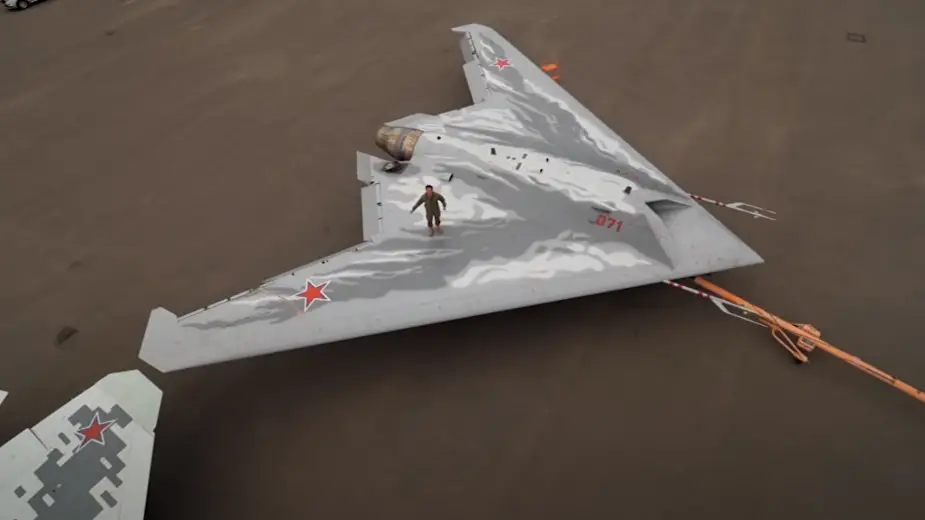The first flight prototype of the latest Russian Okhotnik (Hunter) S-70 strike drone rolled out at the Chkalov Aviation Plant in Novosibirsk (NAZ). Preparations for trials and the first flight are ongoing, Deputy Defense Minister Alexey Krivoruchko said: “The rollout means the assembly of the unit has been completed. It was equipped with onboard devices according to the requirements and is preparing for the maiden flight,” he said.
Follow Air Recognition on Google News at this link

S-70 Okhotnik combat drone (Picture source: YouTube/Zvezda)
Krivoruchko visited Novosibirsk to check the fulfillment of the arms procurement order by the NAZ and chaired a meeting to discuss the fulfilment of state contracts. He inspected the rollout of Okhotnik and the production of the second drone. “The United Aircraft Corporation (UAC) for the first time displayed S-70 Okhotnik with a flat nozzle, which decreases the radar signature,” Rostec CEO Sergey Chemezov said.
UAC CEO Yuri Slyusar said Okhotnik program is a key guideline for the Sukhoi Company and the UAC. “We take all effort to complete trials as soon as possible and launch batch production”, he said.
The Sukhoi Design Bureau created the Okhotnik with a hybrid wing and stealth technologies to decrease radar signature. Open sources said the takeoff weight is 20 tons and the maximum speed is close to 1000 km/h. Batch supplies are scheduled in 2024. Okhotnik for the first time took off for 20 minutes under the control of the operator on August 3, 2019. On September 27, 2019, it made a flight together with the Su-57 fighter jet.
The motor designer of the drone engine said the second Okhotnik will be powered by an engine with a flat nozzle. It is produced by 3D print and decreases the signature of the drone for thermally guided missiles. The UAC said the new drone will be able to operate together with Sukhoi Su-57 fifth-generation fighter jet. Okhotnik will interact with it in a netcentric way and destroy air and ground targets. A source in the aircraft industry told TASS the Su-57 pilot will coordinate the actions of four Okhotnik heavy drones at a time. A swarm of drones is likely to be controlled by a new two-seat option of Su-57.
The Defense Ministry said the drone operated in an automated regime during the first flight with Su-57 and entered the zone of combat duty. The drone expanded the radar field of the jet and the guidance area for air weapons.
Defense Minister Sergey Shoigu expressed hope in August that the design of the Okhotnik drone would be completed by 2022 and a major contract for the delivery of the drones to the Russian armed forces would be signed.
Kronstadt Group is developing a special control post for the Okhotnik
A new ground-based control post is being developed for the S-70 Okhotnik (UAV), CEO of Russia’s Rostec state hi-tech corporation Sergei Chemezov said. “A new ground-based control post is being developed for the drone, taking into account the requirements set by the military,” the Rostec corporation’s press office quoted Sergei Chemezov as saying. According to him, this solution and the development of a flat nozzle will boost the drone’s capabilities: “Technologies tested on prototypes will be used to develop other promising manned and unmanned aerial vehicles,” Chemezov said.
Earlier, the Kronstadt Group said that it was developing a standardized ground-based control post for medium and heavy unmanned aerial vehicles. According to the group, the new ground-based control post can be used to control drones at any part of the world.
Okhotnik production requires component development and testing
The production of the S-70 Okhotnik requires the development and testing of all components as it cannot be assembled from component parts available on the market, like many foreign drones, Russian Deputy Defense Minister Alexei Krivoruchko said: “UAVs of this type can be produced only by countries with a developed aviation industry that offers a full development cycle, from designing to manufacture and all types of tests, as well as the development and production of all necessary ground and airborne equipment,” Krivoruchko said during a working trip to Novosibirsk. “Unmanned aerial vehicles of this type cannot be assembled from components available on the market, like a number of foreign analogs,” he said.
© Copyright 2021 TASS. All rights reserved. This material may not be published, broadcast, rewritten or redistributed.
















